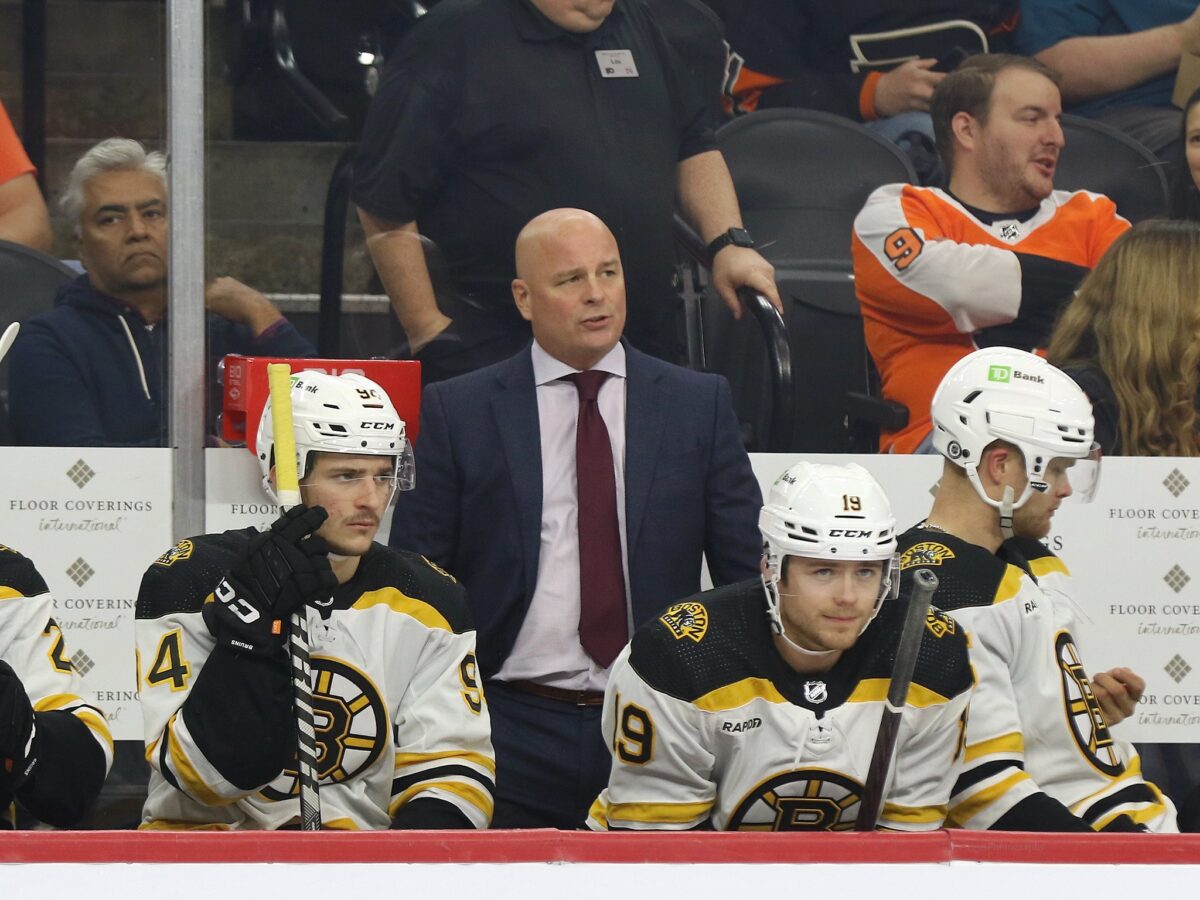As the preseason plods along, roster battles continue to heat up, and the Boston Bruins continue to absorb head coach Jim Montgomery’s new systems. At a practice earlier this week, a new power-play unit was thrown together. Rather than the typical four forwards, one defenseman set that is standard practice around the league, the Bruins went with five forwards and no defensemen. With Brad Marchand and Charlie McAvoy absent from the top unit recovering from injuries, Montgomery deployed Patrice Bergeron, David Pastrnak, David Krejci, Jake DeBrusk, and Taylor Hall together.
Should the Bruins Use This Group?
The Bruins should absolutely use this group. Last season, their power play finished an uninspiring 15th league-wide. While this position was not the reason Bruce Cassidy was let go as head coach, there is a reasonable assumption that this group of players should have found more success with the man-advantage. This season, at least to start, Montgomery will be without two of the power play’s biggest weapons in Marchand and McAvoy. How does he overcome these losses? By stacking the forwards to create greater offensive firepower.
Related: Bruins Hoping Young Players Benefit From Montgomery’s Approach
Each of these five players also brings a unique skill set to the unit. Pastrnak will operate the left wing faceoff circle where he can power one-timers into the net. Bergeron will operate the bumper role in the middle, acting as a distributor and shooter wrapped into one. DeBrusk will play the front of the net, scurrying after loose pucks to hold onto possession or cleaning up rebounds and free pucks around the net. Hall will start on the right wing but has the creativity to shuffle positions as play dictates while using his speed and shot to create opportunities down his side. Finally, the most important piece, Krejci will run the point, playing a role normally occupied by a defenseman to find the open lanes and start the process of finding a shot.

While Krejci’s role will be as a facilitator, he also possesses the shot to remain a scoring threat from the point. He should be comfortable taking on this role, as he has always possessed a complete game, meaning he won’t slack his defensive responsibilities on the power play.
On top of the group of players available, it is important to consider who isn’t available. With McAvoy and Matt Grzelcyk both out to start the season, the Bruins are missing their power-play quarterbacks. Finding one replacement is challenging enough, but finding two? That would be difficult, given the profiles of defensemen on the team.
Hampus Lindholm could operate a power play, but he is not the offensive catalyst that would fit into a top unit. Also, as Boston’s top, healthy defenseman, there is a case to be made for Lindholm being held in reserve with Brandon Carlo to shut down the offensive response an opponent will often counter with coming out of a penalty.
After Lindholm, the next group to pick from would be Derek Forbort, Brandon Carlo, Connor Clifton, or Anton Stralman, assuming Stralman earns a roster spot from his PTO. None of these guys are offensive juggernauts, so these four are non-starters for power play time.

The final group to pick from would be Mike Reilly and Jakub Zboril. Both are left shots who look to use their skating and offensive touch to influence the game. In theory, that would make a strong option for the power play. However, Reilly is looking more and more like the odd man out that will get traded to allow for cap compliance by the Bruins, so he won’t be considered. Zboril is an intriguing prospect, but he never played extended minutes above the third pairing last season before his ACL tear. He could step into a second power play role, where he can gain some confidence and begin to build his offensive pedigree, but handing the reigns to him for the first unit would be a mistake.
That means five forwards may be the best option. Besides being the most exciting and hopefully creating the greatest number of offensive opportunities, this decision could be driven by the personnel available at the beginning of the season.
Does this Match Montgomery’s Style?
Absolutely. Montgomery’s mandate is to increase offense, and this is a perfect way to fulfill that. He has continually preached an offensive approach that will combine movement with multiple layers. On the power play, that can be seen in players like Hall and Krejci switching or Hall and DeBrusk trading spots to alter the look the penalty killers must adjust to. The layering comes in the form of multiple players screening the goalie and being available for tips or redirects.

On top of this fluidity, the forwards chosen by Montgomery, specifically Krejci at the point, can manage the defensive responsibility this formation would require. This unit for the Bruins will have to work together to create opportunities, and this cohesion will encourage the recovery back into a defensive front should play break down.
Can 5 Forwards Operate a Power Play League-Wide?
This strategy has been used occasionally throughout the league over the last few years. Most of the time, it’s a last resort to jumpstart the offense when a team is trailing in the third period. The Bruins’ version could very well be that same thing, but I would hope that it warrants more consideration as the true first unit, as I think that could be an advantage that other teams are not utilizing.
As with everything, this unit is only penciled in. If the Bruins are playing with a lead in the third period, it would be no surprise at all to move Hall off for Lindholm or Krejci and Hall off for Lindholm and Carlo to continue playing with a defensive posture to run out the clock.
If this power play experiment finds its way over the boards following the first infraction called against the Washington Capitals in two weeks, we will have our answer. Is this planning for a late-game push, or is this the expected top unit for the Bruins? I, for one, hope it is the top unit and Boston can take advantage of maximizing their offensive opportunities in a way other teams have not done.
Don’t forget, only a few years ago, it was rare to see the four forward, one defenseman power play setup that now is featured league-wide. This could be the next trend, and the Bruins could be at the cutting edge.